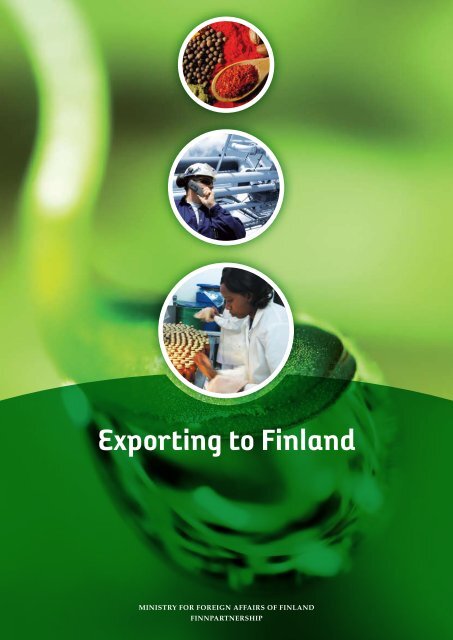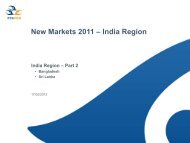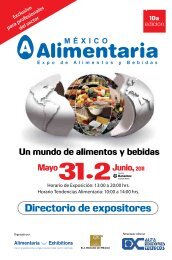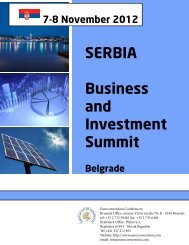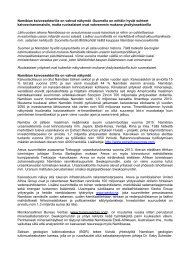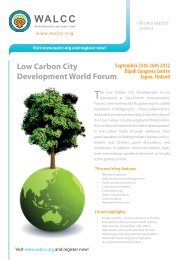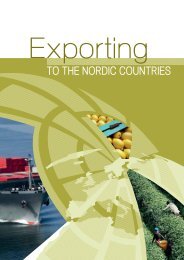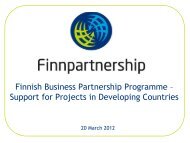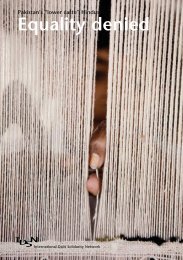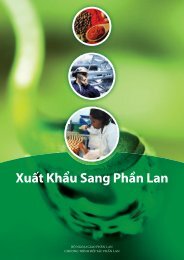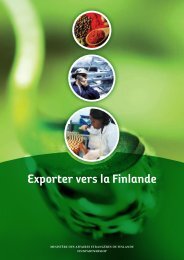Exporting to Finland -guide
Exporting to Finland -guide
Exporting to Finland -guide
Create successful ePaper yourself
Turn your PDF publications into a flip-book with our unique Google optimized e-Paper software.
<strong>Exporting</strong> <strong>to</strong> <strong>Finland</strong><br />
MINISTRY FOR FOREIGN AFFAIRS OF FINLAND<br />
FINNPARTNERSHIP
Contents<br />
3 Foreword<br />
4 <strong>Finland</strong> as an export market<br />
9 Complying with legal requirements<br />
15 Private sec<strong>to</strong>r standards and codes –<br />
an inevitable part of <strong>to</strong>day’s business<br />
19 From export price <strong>to</strong> retail price<br />
22 Further information<br />
Pho<strong>to</strong>s: Association for<br />
Promoting Fairtrade<br />
in <strong>Finland</strong>: 6, 7, 13<br />
and Shutters<strong>to</strong>ck<br />
Layout: Innocorp Oy<br />
Printed by: Erweko Oy 2008
Foreword<br />
Developing countries are becoming increasingly important trading<br />
partners for <strong>Finland</strong>. In recent years, imports from developing<br />
countries have outstripped the growth of imports from developed<br />
countries by a significant margin. A growing demand for<br />
new products and services opens up opportunities for both<br />
small and large exporters from developing countries. At the<br />
same time, Finnish consumers are concerned about product<br />
safety, environmental sustainability, and decent working<br />
conditions, and require that producers and service providers<br />
adhere <strong>to</strong> a high quality and ethical standards.<br />
This publication is intended <strong>to</strong> serve as a user-friendly handbook<br />
for small and large exporters from developing countries<br />
interested in exporting <strong>to</strong> <strong>Finland</strong>. While the focus is on the<br />
facilitation of trade from developing countries, I hope that the information<br />
provided in this publication will benefit interested exporters regardless<br />
of their origin. It provides an overview of the Finnish market, business practices as well as the required<br />
standards and regulations. Procedures related <strong>to</strong> exporting <strong>to</strong> <strong>Finland</strong> may seem complicated, but<br />
assistance in complying with the required rules and regulations as well as in finding potential partners<br />
in <strong>Finland</strong> can be obtained from several ac<strong>to</strong>rs. Further information and contact details are provided<br />
at the end of this publication.<br />
<strong>Finland</strong> is a Member State of the European Union and a relatively small country, which can be a<br />
good stepping-s<strong>to</strong>ne for aspiring exporters <strong>to</strong> the wider European markets. Regulations and practices<br />
in <strong>Finland</strong> and the European Union are <strong>to</strong> a large extent harmonized. Therefore, this publication provides<br />
useful information also <strong>to</strong> exporters interested in other European countries.<br />
This publication is a part of <strong>Finland</strong>’s ongoing efforts <strong>to</strong> promote trade with developing countries<br />
and <strong>to</strong> provide them with opportunities <strong>to</strong> better participate in the global economy. I hope that it will<br />
be a useful <strong>to</strong>ol for foreign companies, Governments and NGOs in providing information on <strong>Finland</strong> as<br />
a trading partner.<br />
Minister for Trade and Development<br />
3
<strong>Finland</strong> as an export market<br />
Small country,<br />
high standard of living<br />
<strong>Finland</strong> is the most northern country of the<br />
European Union. Its neighbours are Sweden and<br />
Norway in the west, Russia in the east and Es<strong>to</strong>nia<br />
– across the Gulf of <strong>Finland</strong> – in the south.<br />
The population is about 5.3 million, of which<br />
two thirds live in the urban areas. The capital of<br />
<strong>Finland</strong>, Helsinki, lies on the south coast. Other<br />
bigger cities are Turku, Tampere, Jyväskylä, Kuopio<br />
and Oulu. Around one million people live in<br />
the Helsinki metropolitan area. The population<br />
density is quite low with 15.5 inhabitants per<br />
square kilometre. By their ethnic background,<br />
the population is very homogeneous, only about<br />
2% having a foreign origin. The official languages<br />
are Finnish – 94% of the population speak Finnish<br />
as their mother <strong>to</strong>ngue – and Swedish (6%).<br />
<strong>Finland</strong>’s his<strong>to</strong>ry is very much linked with the<br />
neighbouring countries. In the 12th century, the<br />
first missionaries from Sweden crossed the Baltic<br />
Sea and <strong>Finland</strong> became part of the Swedish<br />
realm. In 1809, Sweden surrended <strong>Finland</strong> <strong>to</strong><br />
Russia and in 1917 <strong>Finland</strong> declared independence<br />
from Russia. In 1995, <strong>Finland</strong> joined the<br />
4
European Union (EU) and introduced<br />
the single currency euro<br />
with the other countries in<br />
the euro area in 2002.<br />
As concerns politics,<br />
<strong>Finland</strong> has a long his<strong>to</strong>ry<br />
of multiparty coalition<br />
governments. After the<br />
latest parliamentary<br />
election in spring 2007,<br />
the Government was<br />
formed by the biggest<br />
parties, the Centre Party<br />
and the National Coalition<br />
Party; Social Democrats are the<br />
biggest party in opposition.<br />
<strong>Finland</strong> is an advanced industrial economy.<br />
The GDP per capita was 33,803 euros in<br />
2007. The value of exports in 2007 was 65.5<br />
billion euros, the major groups being electronics,<br />
machines and appliances as well as metal and<br />
forest products. The EU countries represent<br />
63% of the exports and the biggest countries<br />
outside the European Economic Area 1 are Russia,<br />
USA, China, Japan and the countries of the<br />
Gulf Cooperation Council (GCC).<br />
The value of imports was 59.5<br />
billion euros, of which 56%<br />
came from the EU area.<br />
The major import countries<br />
outside the European<br />
Economic Area<br />
are Russia, China,<br />
USA, Japan and South<br />
Korea.<br />
The value of<br />
imports from developing<br />
countries was 10.1<br />
billion euros, i.e. 17% of all<br />
imports, in 2007. The growth<br />
rate of imports from developing<br />
countries averaged 24% per year from<br />
2004 <strong>to</strong> 2007. The average growth rate of <strong>to</strong>tal<br />
imports was 13%, while imports from the EU<br />
grew on average by 10% during the same period.<br />
In the coming years, the potential for growth<br />
is similar, giving particularly the developing<br />
countries highly promising opportunities for<br />
increasing their business with <strong>Finland</strong>.<br />
Efficiently organised retail<br />
market<br />
The <strong>to</strong>tal value of the Finnish retail market is<br />
approximately 34 billion euros (2007), which is<br />
shared by 29,000 retail s<strong>to</strong>res. Over the past 10<br />
years, consumption has grown by an average of<br />
3% annually. Of the average household budget,<br />
food represents now about 12%, although its<br />
share is declining – growing product groups are<br />
interior, household and health articles.<br />
Department s<strong>to</strong>res sell annually worth over<br />
6 billion euros, food s<strong>to</strong>res (incl. hypermarkets)<br />
over 12 billion euros, clothing specialists close<br />
<strong>to</strong> 2 billion euros and sports goods specialists<br />
around 1 billion euros. The big chains dominate<br />
most retail sec<strong>to</strong>rs. In the food sec<strong>to</strong>r, self-service<br />
5
In the clothing sec<strong>to</strong>r, the market is dominated<br />
by the department s<strong>to</strong>res. Of companies specialising<br />
in clothing, the biggest are H&M, Texmoda<br />
Fashion Group, Seppälä and Lindex (the two latter<br />
are owned by S<strong>to</strong>ckmann).<br />
In sports products, Kesko with its Intersport<br />
dealers and department s<strong>to</strong>res dominate the<br />
market.<br />
Buying and other support <strong>to</strong><br />
s<strong>to</strong>res is centrally organised<br />
s<strong>to</strong>res account for almost 100% of business in<br />
the field, the amount of specialized food service<br />
s<strong>to</strong>res being limited.<br />
The biggest groups are expanding their businesses<br />
also <strong>to</strong> the other Nordic countries, the<br />
Baltic countries and Russia, which means that<br />
dealing successfully with such retail groups can<br />
lead <strong>to</strong> sales <strong>to</strong> a much wider market than only<br />
the Finnish market.<br />
Major players in retail trade<br />
All big chains have strict s<strong>to</strong>re concepts, even<br />
if the s<strong>to</strong>res are run by private entrepreneurs.<br />
S<strong>to</strong>re space planning, buying, logistics, basic<br />
assortment, marketing and even pricing decisions<br />
are made in the central organisation.<br />
This makes life easier for the suppliers as the<br />
negotiation partners are thus few and the buying<br />
volumes in each chain can be centralized. On the<br />
other hand, getting a product chosen <strong>to</strong> a chain’s<br />
basic assortment requires bigger volumes than<br />
selling <strong>to</strong> one or a few s<strong>to</strong>res only, which puts<br />
small suppliers at a disadvantage.<br />
In food products, the big players are S-Group,<br />
Kesko and Tradeka. The S-Group is a consumer<br />
co-operative with a market share of 39.9%<br />
in 2006, whose buying and logistics company is<br />
called Inex Partners. Kesko and the K-retailers<br />
are <strong>to</strong>gether the second biggest group (33.4%).<br />
Tradeka served by Tuko Logistics holds a share<br />
of 11.9% and the German discounter chain Lidl<br />
4.1%. About 10% of the market is held by smaller<br />
companies outside of the big chains.<br />
The three biggest department s<strong>to</strong>res are the<br />
S-Group (Sokos department s<strong>to</strong>res and Prisma<br />
hypermarkets), Kesko (K-Citymarket hypermarkets,<br />
Anttila department s<strong>to</strong>res, Kodin Ykkönen<br />
for home and interior decoration) and S<strong>to</strong>ckmann.<br />
6
A growing part of retailers’ basic assortments<br />
are their own brands, made in compliance with<br />
the retail group’s specifications. Such brands<br />
are typical especially in the food and daily goods<br />
sec<strong>to</strong>r, but advancing also in clothing, home textiles<br />
and other special goods.<br />
A chain´s basic assortment normally covers<br />
60-80% of the sales, but the member retailers<br />
can individually choose plenty of products in<strong>to</strong><br />
their own s<strong>to</strong>re-specific assortments. They buy<br />
such products mainly from nearby suppliers or<br />
– in case of imported products – from so-called<br />
warehouse assortment that the central organisation<br />
offers for this purpose. Thus suppliers<br />
that are <strong>to</strong>o small <strong>to</strong> serve the whole chain still<br />
have numerous possibilities of selling through<br />
the warehouse assortment.<br />
Connections <strong>to</strong> European<br />
alliances<br />
Buying is centralized within each chain not only<br />
nationally, but in many cases also at the European<br />
level. Kesko Food is a member of Associated Marketing<br />
Services (AMS), a strategic buying alliance<br />
based in the Netherlands. The S-Group has its own<br />
channels through CoopNorden, Tuko Logistics is<br />
a member of United Nordic Inc., Bigs and EMD,<br />
Intersport <strong>Finland</strong> is linked with Intersport International<br />
etc. All this means that some purchasing<br />
decisions are made in such buying alliances, and<br />
there are also European-wide own brands, such<br />
as Euroshopper for the AMS members.<br />
Import companies serving retail<br />
groups and individual retailers<br />
The big retail groups normally buy at least<br />
half of the imported goods directly from their<br />
foreign suppliers and take care of the forwarding<br />
of goods and all import bureaucracy. They can also<br />
buy from foreign trading houses, which represent<br />
various small and medium-sized suppliers.<br />
In addition <strong>to</strong> such foreign partners, there<br />
are also many import companies and agents<br />
specialising in certain sec<strong>to</strong>rs, based in <strong>Finland</strong>,<br />
which import and sell products <strong>to</strong> retail groups<br />
and other clients. Most of them are relatively<br />
small family enterprises and therefore used <strong>to</strong><br />
working both with smaller suppliers and with<br />
smaller retail clients. Practically all these agents<br />
are members of the Finnish Foreign Trade<br />
Agents’ Federation, an association of commercial<br />
agents, distribu<strong>to</strong>rs and importers. On its<br />
website (www.agenttiliit<strong>to</strong>.fi) you can find the<br />
members classified by product groups. The<br />
biggest of the 18 groups represent clothing and<br />
footwear; fabrics, leather and accessories <strong>to</strong> garment<br />
industry; and home furnishing and household<br />
articles.<br />
7
Finns are reliable partners<br />
The Finnish business culture is based on high<br />
ethics and standards; the Finns keep their<br />
promises and follow rules and legislation. They<br />
are committed <strong>to</strong> a high level of integrity, and<br />
corruption and bribery rate has always been very<br />
low. In business negotiations, the Finns do not<br />
favour small talk but tend <strong>to</strong> be rather remote<br />
and go very quickly <strong>to</strong> the point. They are very<br />
punctual as <strong>to</strong> agreed hours and very straightforward<br />
in handling issues, and their ’yes’ is definitely<br />
’yes’ and a ’no’ is never a ’perhaps’. Their<br />
frankness may sometimes seem a bit indelicate,<br />
but after getting used <strong>to</strong> it, communicating with<br />
them is straightforward and easy.<br />
If you intend <strong>to</strong> sell products <strong>to</strong> Finnish partners,<br />
it is advisable <strong>to</strong> learn what they value<br />
when doing business: efficient negotiations,<br />
explicit offers and terms, even quality, punctuality,<br />
as well as compliance with law, contracts<br />
and other specified requirements. If the Finns<br />
find reliable suppliers, who see <strong>to</strong> safe and punctual<br />
deliveries and offer excellent price/quality/<br />
ethics relation, they tend <strong>to</strong><br />
build long-lasting business<br />
relations.<br />
Practical advice given by<br />
Finnish buyers<br />
●● Finnish consumers are quality conscious and<br />
familiar with high technology<br />
●● The official languages are Finnish and Swedish,<br />
but English is widely spoken<br />
●● The information supplied in respect of<br />
consumer products and services shall be both<br />
in Finnish and Swedish, or - when applicable -<br />
conveyed by universally known instructive or<br />
cautionary signs or symbols<br />
●● All documents requested by the buyer shall<br />
be appended <strong>to</strong> the invoices and shipments<br />
●● Products shall be equipped with<br />
stickers or labels requested by the buyer<br />
●● Bar codes are used in all retail products<br />
●● Regarding clothing and shoes, the Finnish<br />
sizes/units of measurement should be used<br />
●● It is advisable <strong>to</strong> use the package sizes<br />
requested by the buyer<br />
●● Packages need <strong>to</strong> comply with<br />
environmental requirements<br />
●● Transport and wholesale packages need <strong>to</strong><br />
comply with the standard dimensions<br />
●● Due <strong>to</strong> the small population, the quantities<br />
ordered are smaller than for many other<br />
EU countries<br />
●● Social responsibility in the supply chain is<br />
highly esteemed and favoured<br />
●● With small volumes, it is advisable <strong>to</strong> cooperate<br />
with other small exporters, or work with a<br />
trading house or an agent<br />
●● International exhibitions can serve as a<br />
useful contact point<br />
8
Complying with legal requirements<br />
<strong>Exporting</strong> <strong>to</strong> <strong>Finland</strong> is subject not only <strong>to</strong> Finnish<br />
but also the EU legislation, which can make things<br />
rather complicated. However, all obstacles can<br />
be overcome, after you have found a client who<br />
is seriously interested in your products, trusts<br />
your quality and delivery capacity, and finds your<br />
prices competitive. As your client is in most cases<br />
considered as the importer of your products, he<br />
or she will tell you what is required.<br />
The EU legislation has laid down elaborate<br />
provisions concerning the standards of protecting<br />
consumers, labour and environment. Food<br />
is the most demanding product group, whereas<br />
sec<strong>to</strong>r-specific legislation on many specialty<br />
goods is much more flexible. Of course, the better<br />
the European standards are met at the beginning<br />
of the export efforts, the easier it will be <strong>to</strong><br />
sell <strong>to</strong> the Finnish and other European clients.<br />
And when the business finally begins, there is no<br />
other choice – the requirements have <strong>to</strong> be met.<br />
The EU legislation is enacted in the form<br />
of regulations and directives. Regulations are<br />
directly in force as such in the EU Member<br />
States, whereas directives must be transposed in<br />
the form of binding national legislation in each<br />
Member State. It is impossible <strong>to</strong> describe in this<br />
9
publication all legislation concerning exports<br />
<strong>to</strong> <strong>Finland</strong>. Therefore, only the essential regulations<br />
are mentioned <strong>to</strong>gether with the respective<br />
websites for more detailed information on<br />
the issues. In any case, the relevant legal rights<br />
and obligations should be checked from the<br />
official legislative acts.<br />
Product safety<br />
State has national standards bodies, but since<br />
all national standards have the same origin, the<br />
standard text obtained in <strong>Finland</strong> is valid in<br />
other EU countries and vice versa.<br />
If the production includes chemicals, it is<br />
ne-cessary <strong>to</strong> study the EU regulation on<br />
chemicals and their safe use. The Directive<br />
(EC 1907/2006) is called REACH (Registration,<br />
Evaluation, Authorisation and Restriction of<br />
Chemical substances 4 ) and its aim is <strong>to</strong> improve<br />
the protection of human health and the environment.<br />
Manufacturers and importers will have<br />
greater responsibility <strong>to</strong> manage the risks from<br />
chemicals and <strong>to</strong> register required information in<br />
a central database run by the European Chemicals<br />
Agency (ECHA) in Helsinki, <strong>Finland</strong>.<br />
Manufacturers, importers and distribu<strong>to</strong>rs<br />
must cooperate <strong>to</strong> provide consumers with the<br />
necessary information on product safety either<br />
by labelling the product or giving clear usage<br />
instructions. Importers and distribu<strong>to</strong>rs need <strong>to</strong><br />
moni<strong>to</strong>r the safety of the products they are selling,<br />
and take the necessary measures <strong>to</strong> avoid<br />
threats. This can mean withdrawing the product<br />
from the market, informing consumers, recalling<br />
products that have already been supplied <strong>to</strong><br />
consumers, etc.<br />
The EU has general legislation on product safety:<br />
Directive 2001/95/EC 2 prohibits the placing on<br />
the market of products that pose a risk <strong>to</strong> consumers’<br />
health caused by dangerous substances<br />
or by unsafe construction. The Directive applies<br />
<strong>to</strong> all products on the consumer market. As it<br />
can be seen as a framework directive, it is supplemented<br />
by product-specific safety directives,<br />
such as those covering safety of food products,<br />
<strong>to</strong>ys, children’s articles, electric appliances etc.<br />
The CE (or new Approach) Directives 3 cover<br />
more than 20 different product groups, which<br />
represent a potential risk for the consumer. The<br />
importer is responsible for having such products<br />
marked with the CE mark.<br />
There are also plenty of technical standards<br />
on product requirements. Each EU Member<br />
10
The national market surveillance authorities in<br />
the EU have established a European network<br />
RAPEX 5 , the EU rapid alert system for all dangerous<br />
products except for food, pharmaceuticals<br />
and medical devices. The EU Commission publishes<br />
a weekly overview on RAPEX notifications.<br />
Product liability<br />
Product safety shall always be controlled before<br />
a product enters the market in order <strong>to</strong> avoid<br />
product liability cases. If a consumer can prove<br />
that a defective product has caused him/her personal<br />
injury or property damage, he/she can seek<br />
financial compensation in the first place from the<br />
distribu<strong>to</strong>r under the EU Product Liability Directive<br />
6 . The distribu<strong>to</strong>r is then entitled <strong>to</strong> pass on<br />
the claim <strong>to</strong> the importer, manufacturer or whoever<br />
comes earlier in the distribution chain. The<br />
directive covers all industrial products, but e.g.<br />
agriculture is not included but covered by separate<br />
legislation.<br />
Food Safety<br />
As food safety is a very important issue in Europe,<br />
food products are governed by an extensive set<br />
of regulations. The latest general framework,<br />
which has been implemented in all EU Member<br />
States and has led <strong>to</strong> a complete harmonisation,<br />
is the Food Law Regulation EC178/2002 7 . The<br />
food law aims at ensuring a high level of protection<br />
of human life and health with due regard<br />
for animal health and welfare, plant health and<br />
the environment. This integrated ”from-farm-<strong>to</strong>fork”<br />
approach is considered a general principle<br />
for the EU food safety policy.<br />
The legislation concerning food will be continuously<br />
developed. Product requirements cover<br />
such areas as contaminants, maximum residue<br />
levels, hygiene (EU Food Hygiene Regulations<br />
EC852, 853 and 854/2004 and Hazard Analysis<br />
and Critical Control Point (HACCP) systems),<br />
irradiation, labelling and much more, depending<br />
on the product. For example, food products of<br />
animal origin must come from an establishment<br />
approved by the EC, special health certificates<br />
are required, and the products are inspected<br />
and tested upon arrival and need <strong>to</strong> be approved<br />
before being released.<br />
Foodstuffs sold as ”organic” must comply with<br />
the EU regulations (EEC2092/91) and be certified<br />
by an independent body and labelled accordingly.<br />
The special requirements <strong>to</strong> exports of<br />
organic products from developing countries are<br />
laid down in Council Regulation EC1788/2001 8 .<br />
11
Packaging and labelling<br />
The main aim of packaging is <strong>to</strong> ensure that the<br />
original quality and hygiene of the product will<br />
last until it reaches the consumer. There are<br />
also a number of legal requirements for packaging<br />
and labelling different goods depending on<br />
whether they are destined for industrial or consumer<br />
use. Again, the purpose is <strong>to</strong> protect consumer<br />
health and safety and provide them with<br />
relevant information about the products.<br />
A group of EU Directives (framework regulation<br />
EC 1935/2004) 9 specify, which materials,<br />
types of plastic and cardboard can be used in<br />
packaging in direct contact with foodstuffs.<br />
Packaging Directive 10 , contains provisions on the<br />
prevention of packaging waste, on the re-use of<br />
packaging and on the recovery and recycling of<br />
packaging waste – the importer is responsible<br />
for implementing this directive. There is also a<br />
Directive on Textile Names 11 laying down rules<br />
for the compulsory labelling of textiles as well as<br />
numerous directives on food labelling, countryof-origin<br />
labelling etc.<br />
General rules for labelling<br />
●● Consumer products must be labelled in the<br />
national language(s) of the market country,<br />
or – when applicable – by universally known<br />
instructive or cautionary signs or symbols<br />
●● Labels and markings must accurately describe<br />
the contents of the package<br />
●● Weight and measurements must be stated<br />
in the metric system<br />
●● Information on safe use must be included,<br />
if applicable<br />
●● Certain foodstuffs must be marked with the<br />
country of origin<br />
●● CE marking is manda<strong>to</strong>ry for many products<br />
Demonstration of compliance<br />
Importers have <strong>to</strong> document compliance with<br />
legal requirements. For low-risk products, there<br />
are not always specific requirements, and a<br />
Supplier’s Declaration of Conformity is often<br />
sufficient. For higher-risk products, product<br />
properties may have <strong>to</strong> be verified by means of<br />
producing labora<strong>to</strong>ry test reports or inspection<br />
reports. In some cases (e.g. organic products)<br />
an independent certification is necessary. The<br />
requirements regarding demonstration of compliance<br />
are laid down in the EU directives and<br />
other legislation, but the practical procedures<br />
may vary from country <strong>to</strong> country.<br />
For test reports and certificates, recognised<br />
European labora<strong>to</strong>ries and certification bodies<br />
shall be used. Accreditation by an internationally<br />
recognised accreditation body confirms the<br />
competence of the organisation in question and<br />
enhances the value of their test report or certificate.<br />
If the European authorities do not recognise<br />
a given documentation, additional testing<br />
or inspection may be required when the<br />
product arrives in Europe, which leads <strong>to</strong> delays<br />
and extra costs. In certain cases, the EU may<br />
send inspec<strong>to</strong>rs <strong>to</strong> the country of origin.<br />
12
EU cus<strong>to</strong>ms duties<br />
In the EU single market area, there are no cus<strong>to</strong>ms<br />
duties on the sale of products produced<br />
in one EU country and sold <strong>to</strong> another. Importing<br />
products <strong>to</strong> the EU from a country outside<br />
the EU may be subject <strong>to</strong> cus<strong>to</strong>ms duties and<br />
in some cases also <strong>to</strong> import quotas, although<br />
these are often at a modest level. However, there<br />
are free trade arrangements between non-EU<br />
countries and the EU, as well as au<strong>to</strong>nomous<br />
preferences given by the EU. The duties are<br />
often applied as a percentage of the cus<strong>to</strong>ms<br />
value of the goods. For agricultural products,<br />
specific duties based on quantity or weight or<br />
a combination of percentage and weight-based<br />
duties may be applied. Once products originating<br />
from countries outside the EU have arrived<br />
<strong>to</strong> the EU area and the cus<strong>to</strong>ms formalities have<br />
been completed, the products are released in<strong>to</strong><br />
free circulation in the single market area.<br />
Developing countries have benefited from<br />
preferential treatment of their export <strong>to</strong> the<br />
developed countries for nearly 40 years. One<br />
of the arrangements is the Generalized System<br />
of Preferences (GSP). Under the GSP regime,<br />
products imported <strong>to</strong> the EU from developing<br />
countries are granted tariff reductions. Products<br />
included in the regime are divided in<strong>to</strong> a<br />
sensitive and a non-sensitive category. Industrial<br />
goods – with the exception of textiles – are<br />
primarily non-sensitive products and subject<br />
<strong>to</strong> zero duty. Most agricultural products belong<br />
<strong>to</strong> the sensitive category, where limited tariff<br />
reductions are applied.<br />
In addition, countries that are beneficiaries<br />
of the special incentive arrangement for sustainable<br />
development and good governance (GSP+)<br />
enjoy duty free access for all products, including<br />
sensitive products.<br />
The best terms are granted <strong>to</strong> the Least<br />
Developed Countries (LDCs), which receive<br />
duty and quota free access for all products with<br />
the exception of arms under the EU’s Everything<br />
But Arms arrangement. This also includes duty<br />
and quota free access for agricultural products<br />
with a few exceptions (rice and sugar, which will<br />
be phased out by the end of 2009).<br />
In addition <strong>to</strong> these, the EU gives au<strong>to</strong>nomous<br />
preferences also <strong>to</strong> the Overseas Countries and<br />
Terri<strong>to</strong>ries (OCTs) 12 . This usually means dutyfree<br />
access <strong>to</strong> the EU market.<br />
There are also free trade arrangements<br />
between the EU and the ACP countries (ACP=<br />
Africa, Caribbean, Pacific) that are based on the<br />
Economic Partnership Agreements (EPAs) or<br />
temporary market access arrangements preceding<br />
EPAs, earlier known as the Co<strong>to</strong>nou Agreement.<br />
In addition, there are also preferential<br />
duty regimes under the Free Trade Agreements<br />
13
How <strong>to</strong> benefit from lower<br />
cus<strong>to</strong>ms duties<br />
●● The product must originate from a<br />
developing country which is a beneficiary of<br />
one of the EU’s preferential arrangements<br />
(GSP, GSP+, EBA, EPA or FTAs)<br />
●● The product must be included in the range of<br />
products covered by the relevant scheme<br />
●● The product must satisfy the rules of origin<br />
criteria, complemented with satisfac<strong>to</strong>ry<br />
documentation<br />
●● Different certificates of origin issued by<br />
competent authorities in the export country<br />
must be used: Form A (GSP) or EUR.1<br />
certificates (EPAs and OCTs)<br />
●● Transportation must be directly from the<br />
country of origin <strong>to</strong> <strong>Finland</strong> (or through<br />
another EU country or Switzerland)<br />
●● The importer must claim preferential<br />
treatment at cus<strong>to</strong>ms clearance<br />
(FTAs) for example with Mexico, Chile, South<br />
Africa and some Mediterranean countries (Euro-<br />
Mediterranean agreements).<br />
When the correct code of a product in the<br />
Harmonized Commodity Description and Coding<br />
System (HS code) is known, the preferences and<br />
duties can be checked at an EU export helpdesk<br />
(http://exporthelp.europa.eu). The database can<br />
also be searched by product name. Exporters of<br />
food products are also advised <strong>to</strong> make themselves<br />
familiar with the rules on import licences<br />
and securities (www.mavi.fi), even though normally<br />
the buyer in <strong>Finland</strong> will take care of such<br />
arrangements.<br />
considered as originating from a beneficiary<br />
country, if it is wholly obtained or sufficiently<br />
processed in that country. If it contains elements<br />
from other countries or is processed<br />
partially elsewhere, the rules of origin define<br />
the origin of the product.<br />
Countries belonging <strong>to</strong> certain groups:<br />
ASEAN (South East Asia), SAARC (South Asia)<br />
and the Andean Community (in South America)<br />
have the right <strong>to</strong> use material from other countries<br />
in their group without losing the country of<br />
origin status. In some cases, exports from LDCs,<br />
EPA countries or OCTs <strong>to</strong> the EU can be granted<br />
relaxation of the rules of origin.<br />
To prove that the rules of origin are fulfilled,<br />
the exporter has <strong>to</strong> provide the necessary documentation:<br />
for the GSP treatment Form A certificate<br />
of origin or an invoice declaration for<br />
smaller consignments, and for other preferential<br />
treatment regimes mainly EUR.1 certificate or<br />
an invoice declaration.<br />
The EU Commission is expected <strong>to</strong> renew<br />
the Rules of Origin when deciding on the GSP<br />
for 2009-2012. This may lead <strong>to</strong> some changes <strong>to</strong><br />
what has been explained above. The EU export<br />
helpdesk also provides information on the rules<br />
of origin.<br />
Rules of origin<br />
To benefit from preferential treatment, the<br />
export product must originate from a country<br />
covered by a free trade arrangement or a preferential<br />
arrangement. A product is generally<br />
14
Private sec<strong>to</strong>r standards and codes –<br />
an inevitable part of <strong>to</strong>day’s business<br />
Finnish retail groups, as well as similar groups<br />
all around the EU, are keen on safeguarding<br />
their reputation. Stakeholders want <strong>to</strong> know<br />
every detail of companies’ behaviour in different<br />
situations and put a lot of pressure on legisla<strong>to</strong>rs<br />
<strong>to</strong> produce more rules and regulations <strong>to</strong> control<br />
companies. Media is active and keeps these<br />
issues in the spotlight, especially if they find<br />
non-compliance with the rules or other unethical<br />
behaviour. Additionally, for example consumers<br />
pay more and more attention <strong>to</strong> the conditions<br />
in the supply chain, especially <strong>to</strong> the effects of<br />
production on environment and labour. Even if<br />
compliance with private sec<strong>to</strong>r standards is not<br />
required by law, private companies often set it<br />
as a precondition of business in practice.<br />
Corporate responsibility is<br />
promoted<br />
The key word is corporate responsibility, which<br />
lies on three pillars: economic, environmental<br />
and social responsibility. In 2003-2004, the<br />
15
EU Commission set up a working group, called<br />
EU Multistakeholder Forum on Corporate<br />
Responsibility, in order<br />
<strong>to</strong> get all relevant stakeholders<br />
<strong>to</strong>gether <strong>to</strong> tackle the<br />
issue. The outcome<br />
of these discussions<br />
was a statement<br />
that all necessary<br />
rules already exist:<br />
national laws, EU<br />
Directives, international<br />
environmental<br />
agreements,<br />
conventions of the<br />
International Labour<br />
Organisation ILO, Universal<br />
Declaration of<br />
Human Rights, Convention<br />
on the Rights of the Child, etc.<br />
The basic problem is that many of<br />
the internationally agreed conventions and<br />
agreements aimed at protecting the environment<br />
and employees have not been implemented efficiently<br />
enough in the national legislation of many<br />
developing countries.<br />
Standards and codes are<br />
useful <strong>to</strong>ols<br />
Many companies with experience in international<br />
trade have started <strong>to</strong> publish Codes of<br />
Conduct. These documents normally include the<br />
company´s requirements for the suppliers on<br />
labour laws and certain environmental issues,<br />
and they also express the ethical rules the buyers<br />
need <strong>to</strong> follow when dealing with the sup<br />
pliers. Very often the Codes are based on<br />
standards since companies do not want <strong>to</strong><br />
deviate from such internationally accepted principles.<br />
Codes are also auditable; often the buyer<br />
company audits the suppliers, but these audits<br />
can also be given <strong>to</strong> an independent body.<br />
Finnish retail groups – as well as industries<br />
using subcontrac<strong>to</strong>rs – are very happy about<br />
standards and codes, as they bring a common<br />
language and common requirements in<strong>to</strong> the<br />
negotiations and there is no need <strong>to</strong> establish any<br />
own rules. For the suppliers, it also makes sense<br />
<strong>to</strong> avoid excess moni<strong>to</strong>ring by going through one<br />
single certification audit which is then valid for all<br />
cus<strong>to</strong>mers.<br />
Process quality management<br />
The most common quality management system<br />
is the international ISO 9000 standard – cur-<br />
The EU working group decided <strong>to</strong> motivate<br />
businesses <strong>to</strong> strengthen the existing voluntary<br />
efforts and <strong>to</strong> create new ones. Typical voluntary<br />
measures are the use of quality, environmental<br />
and social standards and reporting <strong>guide</strong>lines as<br />
well as participation in global, national or sec<strong>to</strong>ral<br />
initiatives. In many cases, buyers use standards<br />
as part of their basic requirements <strong>to</strong> the suppliers.<br />
Even if not officially required, a certified<br />
supplier is always favored compared <strong>to</strong> a non-certified<br />
supplier. Certification is always carried out<br />
by specialised, trained audi<strong>to</strong>rs of a neutral standard<br />
certification body. As concerns ISO standards,<br />
you can find the standards bodies at www.iso.org.<br />
16
ently there are more than 500,000 certified<br />
organisations world-wide. In ISO 9000, there are<br />
requirements on management and organisation,<br />
documentation, resource management, process<br />
control and improvement. Successful implementation<br />
of the standard improves product and<br />
process quality, efficiency and reliability.<br />
Especially in the food sec<strong>to</strong>r, product safety<br />
is an extremely important issue throughout the<br />
chain. The Hazard Analysis and Critical Control<br />
Point (HACCP) system is in many cases a legal<br />
requirement but, due <strong>to</strong> increasing market pressure,<br />
it is applied also voluntarily.<br />
Food suppliers are also advised <strong>to</strong> make themselves<br />
familiar with the principles and standards<br />
of the Global Food Safety Initiative run by CIES<br />
- The Food Business Forum, a global organisation<br />
of food retail groups and food industry. All<br />
the big companies – al<strong>to</strong>gether 400 of them – are<br />
members of CIES (www.ciesnet.com).<br />
Environmental management<br />
The second best known ISO standard is the environmental<br />
management standard ISO 14000,<br />
with almost 70,000 certifications. In accordance<br />
with ISO 14000, organisations must identify and<br />
moni<strong>to</strong>r their relevant environmental aspects,<br />
develop an environmental policy and program,<br />
and improve performance. However, specific<br />
targets are not required.<br />
All major Finnish fruit and vegetable retailers<br />
apply the EUREPGAP certification pro<strong>to</strong>col as<br />
a precondition for purchasing. The initiative has<br />
been developed by the biggest European retailers,<br />
and the pro<strong>to</strong>col defines the elements of good<br />
agricultural practices (GAP). GAP standards on<br />
environmental, economic and social sustainability<br />
are applied <strong>to</strong> farming and post-production processes.<br />
In addition <strong>to</strong> fruit and vegetables,<br />
EUREPGAP has specific standards for feed,<br />
lives<strong>to</strong>ck, flowers and coffee. There are around<br />
65,000 EUREPGAP-certified farms, mainly outside<br />
Europe. It is important <strong>to</strong> notice that in 2007,<br />
the standard was<br />
named GLOBALGAP.<br />
In some food<br />
products you will find<br />
smaller certification<br />
schemes such as Rainforest<br />
Alliance (mainly<br />
coffee and fruit) and UTZ<br />
CERTIFIED coffee etc. The EU<br />
and most other countries also have<br />
detailed criteria for organic production, specifying<br />
the preconditions, under which the producer<br />
can be granted the organic label.<br />
Working conditions<br />
An increasingly important part of corporate<br />
responsibility and supply chain management<br />
is social quality control of suppliers. This is especially<br />
true in developing countries. Social quality<br />
refers <strong>to</strong> decent working conditions, including<br />
health and safety, and fair terms of employment.<br />
At international level, the minimum labor<br />
standards have been agreed by the United<br />
Nations and the International Labor Organisation<br />
(ILO) <strong>to</strong> be implemented in the national<br />
legislation. The Finnish retail groups and their<br />
European counterparts want <strong>to</strong> make sure that<br />
suppliers comply with the ILO standards, applicable<br />
national laws and regulations and other<br />
statu<strong>to</strong>ry requirements, whichever are most<br />
stringent. Such requirements are a typical basis<br />
for company codes, social quality initiatives and<br />
social standards. The list of issues <strong>to</strong> be moni<strong>to</strong>red<br />
consists of freedom of association, child<br />
labor, forced labor, working hours, compensation,<br />
discrimination as well as health and safety.<br />
The biggest European initiative on social<br />
quality is Business Social Compliance Initiative<br />
(BSCI) with close <strong>to</strong> 100 retail chains as members,<br />
among them Kesko, Inex Partners, Intrade<br />
Partners, S<strong>to</strong>ckmann and Tuko Logistics from<br />
<strong>Finland</strong>. The BSCI has a very thorough handbook<br />
– both for processing industry and primary pro-<br />
17
duction – that<br />
the BSCI members<br />
distribute<br />
<strong>to</strong> the suppliers<br />
who want<br />
<strong>to</strong> cooperate<br />
with the scheme.<br />
The process starts<br />
with filling in a selfassessment<br />
form, which<br />
is almost similar <strong>to</strong> the audit<br />
questionnaire and helps the supplier<br />
implement necessary adjustments<br />
before inviting the audi<strong>to</strong>r. BSCI audits are<br />
always carried out by international certification<br />
bodies, and the audit reports are fed in<strong>to</strong> a common<br />
database on the BSCI website, letting all<br />
members interested in the supplier see the audit<br />
results and thus avoid multiple audits.<br />
BSCI audits do not lead <strong>to</strong> a certification,<br />
because they do not cover management systems<br />
and documentation as thoroughly as ISO standards<br />
do. If a supplier wants <strong>to</strong> become certified,<br />
the next step after BSCI approval is <strong>to</strong> build the<br />
required management system and ask the same<br />
audi<strong>to</strong>r <strong>to</strong> carry out a Social Accountability SA<br />
8000 audit. SA 8000 is a global social standard,<br />
developed by a U.S. organisation called Social<br />
Accountability International.<br />
In the food sec<strong>to</strong>r, Fair Trade certification<br />
consists mostly of the same social issues as the<br />
SA 8000 and the BSCI, with the difference that<br />
Fair Trade includes environmental requirements<br />
and guarantees the producers both a steady<br />
minimum price and a certain premium <strong>to</strong> be<br />
used for social development projects. In 2007,<br />
around 300 different Fair Trade products were<br />
sold in <strong>Finland</strong> by various licence holders (all big<br />
retail chains as well as many smaller shops) <strong>to</strong> a<br />
<strong>to</strong>tal value of over 30 million euros. In addition <strong>to</strong><br />
foodstuffs, the Fair Trade assortment now consists<br />
of flowers, cosmetics and cot<strong>to</strong>n clothes.<br />
Ethical consumption opens up new markets<br />
Finnish import companies have already built partnerships<br />
with companies in developing countries. A Finnish<br />
tea import and wholesale company imports tea from<br />
more than 20 countries. In order <strong>to</strong> avoid intermediaries,<br />
this company buys directly from the tea-producing<br />
countries and the products are flavoured and packed at<br />
its fac<strong>to</strong>ry in <strong>Finland</strong>. Some of the products are exported<br />
<strong>to</strong> Russia, Sweden, Switzerland, Belgium and the Baltic<br />
countries.<br />
The company’s product range includes 11 types of tea<br />
produced on tea plantations in India and South Africa<br />
that have been awarded FairTrade certification. The Fair-<br />
Trade mark on a product guarantees that the producer<br />
communities in developing countries receive a fair payment<br />
for their work.<br />
According <strong>to</strong> the Managing Direc<strong>to</strong>r of the company,<br />
FairTrade opens up market opportunities for new products<br />
because the Finns appreciate and require ethical<br />
and sustainable production methods.<br />
Despite its ethical nature, the same economic rules<br />
apply <strong>to</strong> the FairTrade business as <strong>to</strong> any other kind of<br />
trade. “If the quality of the product is not good, the consumer<br />
only buys the ethically produced item once. That’s<br />
why for us the most important thing is how the tea tastes<br />
– the added value provided by the ethical aspect has<br />
no use if the basic things are not in order,” explains the<br />
Managing Direc<strong>to</strong>r. This is one reason why the company<br />
selected its first FairTrade teas from the same producers<br />
it had already been doing business with.<br />
FairTrade producers are often small and this may be<br />
a challenge from the viewpoint of the importer. “If Fair-<br />
Trade producers’ volumes do not meet the demand, they<br />
should either join forces or work with an export agent<br />
who also deals in ordinary products,” says the Managing<br />
Direc<strong>to</strong>r. In this way small producer communities also<br />
accumulate know-how about issues related <strong>to</strong> quality<br />
and standardization.<br />
“If a company wants <strong>to</strong> export <strong>to</strong> <strong>Finland</strong>, it has<br />
<strong>to</strong> make itself known by coming here, for example by<br />
attending the relevant trade fairs. Another option is <strong>to</strong><br />
participate in the major trade fairs in Europe and invite<br />
the Finnish business partners there. Doing business is<br />
always easier if you know your negotiating partners and<br />
the available products properly,” he says.<br />
18
From export price <strong>to</strong> retail price<br />
Before a product is on sale in a Finnish retail<br />
s<strong>to</strong>re, plenty of practical measures have been<br />
taken, most of which also have an influence on<br />
the final retail price.<br />
Terms of delivery and payment<br />
In the negotiations with suppliers, not only the<br />
export price but also the terms of delivery, transport<br />
and payment are discussed. The decisions<br />
then taken will determine, which party carries<br />
responsibility for the costs arising from loading<br />
and unloading, transport, duty payments, insurance<br />
etc., and which costs the supplier needs<br />
<strong>to</strong> add <strong>to</strong> the export price.<br />
Incoterms 2000, developed by the International<br />
Chamber of Commerce (ICC), is an<br />
internationally recognized <strong>to</strong>ol for clarifying the<br />
responsibilities. Different terms of delivery, such<br />
as FOB, CIF, EX-WORKS and FAS, are commonly<br />
applied. For more information on Incoterms<br />
see www.iccwbo.org/index_incoterms.asp.<br />
The importer often pays for the transport<br />
and, if new on the market, may want information<br />
and advice from the supplier on existing options.<br />
19
Cus<strong>to</strong>ms duties, Value Added Tax<br />
(VAT), surtaxes<br />
As explained on page 13, exports <strong>to</strong> the EU<br />
Member States are subject <strong>to</strong> cus<strong>to</strong>ms duties,<br />
with some exceptions, especially for the LDCs.<br />
The rate of duty usually ranges from 5 <strong>to</strong> 14%<br />
for industrial products. For agricultural products,<br />
the system is somewhat more complicated.<br />
The duty is collected when the product enters<br />
the country. When counting the duty, the transport<br />
costs <strong>to</strong> the EU are counted in the import<br />
price. Another cost at the border is the Value<br />
Added Tax (VAT), which in <strong>Finland</strong> is 17% on<br />
food and 22% on other products. Before counting<br />
the VAT of an imported product, the duty,<br />
possible surtaxes and transport <strong>to</strong> the destination<br />
are added <strong>to</strong> the import price. The<br />
importers, wholesalers and retailers pay VAT on<br />
the respective value they add <strong>to</strong> the price.<br />
In <strong>Finland</strong>, there are also surtaxes on some<br />
products, such as alcohol and <strong>to</strong>bacco. These<br />
taxes can be even higher than the VAT.<br />
Alternatively, all charges on the way <strong>to</strong> the final<br />
destination may be born by the seller. Whichever<br />
party takes responsibility for the transport, it<br />
is advisable <strong>to</strong> use the services of a forwarding<br />
agent or a shipping agency.<br />
Fast and reliable delivery is of utmost importance<br />
these days. Most Finnish cus<strong>to</strong>mers<br />
have a close-<strong>to</strong>-zero <strong>to</strong>lerance on delays, and<br />
failures in this field may soon lead <strong>to</strong> cancellation<br />
of orders and termination of the cooperation.<br />
As concerns payment, the importer is interested<br />
in getting the best possible terms of credit,<br />
whereas the exporter wants fast and reliable<br />
payment. The most common international terms<br />
of payment and their risks <strong>to</strong> sellers and buyers<br />
can be studied e.g. at www.foreign-trade.com/<br />
reference/payment.cfm.<br />
20
Trade margins<br />
The final retail price paid by the consumers<br />
depends on the amount of intermediaries in the<br />
product chain, the type of product and market,<br />
and the competitive situation.<br />
Today, Finnish retailers tend <strong>to</strong> reduce the<br />
number of intermediaries in order <strong>to</strong> keep the<br />
prices down. Therefore, many large retailer<br />
groups skip the wholesalers and buy directly<br />
from the importers, or skip also the<br />
separate importers and instead import themselves<br />
directly from the suppliers. As explained<br />
on page 5, the Finnish market has developed<br />
very much <strong>to</strong>wards the integration of the wholesale<br />
and retail trade, which lowers costs and<br />
improves competitiveness.<br />
Typical retail margins are 30-40% of the sales<br />
price in specialty goods, such as clothing, home<br />
textiles, shoes, sporting goods etc., and 20-30%<br />
in foodstuffs and other daily consumer goods.<br />
A pricing example<br />
Supplier´s export price (FOB) 100,00<br />
+ freight, insurance etc. 15,00<br />
CIF price at the Finnish border 115,00<br />
+ duty (normally 5-14%) 15,00<br />
Landed cost 130,00<br />
Retail group´s margin (own importing)<br />
+ margin 40% of retail price 86,67<br />
Retail price (excl. VAT) 216,67<br />
+ VAT 22% 47,67<br />
Selling price <strong>to</strong> consumer 264,34<br />
1<br />
The Agreement creating the European Economic Area<br />
covers Norway, Iceland and Liechtenstein in addition <strong>to</strong><br />
the EU.<br />
2<br />
http://ec.europa.eu/consumers/safety/prod_legis/index_<br />
en.htm<br />
3<br />
ec.europa.eu/enterprise/newapproach/<br />
4<br />
ec.europa.eu/environment/chemicals/<br />
5<br />
ec.europa.eu/consumers/safety/<br />
6<br />
ec.europa.eu/enterprise/regulation/goods/ liability_en.htm<br />
7<br />
ec.europa.eu/food/food/<br />
8<br />
http://eur-lex.europa.eu/en/index.htm<br />
9<br />
http://ec.europa.eu/food/food/chemicalsafety/foodcontact/<br />
eu_legisl_en.htm<br />
10<br />
ec.europa.eu/environment/waste/<br />
11<br />
ec.europa.eu/enterprise/textile/<br />
12<br />
The 21 overseas countries and terri<strong>to</strong>ries (OCT) belong<br />
<strong>to</strong> four EU Member States: Denmark, France, the Netherlands<br />
and the United Kingdom. For more information, see<br />
http://europa.eu/scadplus/leg/en/s05034.htm<br />
21
Further information<br />
The Ministry for Foreign Affairs promotes<br />
imports <strong>to</strong> <strong>Finland</strong> in accordance with the Finnish<br />
Government’s Development Policy Programme<br />
(2007) and the Government’s Trade<br />
Policy Programme (2005). This happens by taking<br />
measures with a view <strong>to</strong> removing obstacles<br />
<strong>to</strong> trade and by providing information services.<br />
Developing countries’ trade capacity is strengthened<br />
by means of allocating development cooperation<br />
resources <strong>to</strong> various ends. The Ministry<br />
welcomes reports on barriers <strong>to</strong> trade encountered<br />
by importers and exporters.<br />
Ministry for Foreign Affairs<br />
Department for External Economic Relations<br />
Unit for Market Access<br />
tradebarrier@formin.fi<br />
Tel. +358 9 160 55524<br />
Fax +358 9 160 55599<br />
http://formin.finland.fi/tradepolicy/importpolicy<br />
(access <strong>to</strong> an electronic form for notifications<br />
on barriers <strong>to</strong> trade)<br />
You can also contact the Finnish embassy in your<br />
country. A list of all embassies is available at:<br />
http://formin.finland.fi/embassies<br />
Finnpartnership is a Finnish business<br />
partnership programme that provides Finnish<br />
companies a gateway for starting commercially<br />
viable activities in cooperation with developing<br />
country ac<strong>to</strong>rs.<br />
Finnpartnership – Finnish Business Partnership<br />
Programme<br />
P.O.Box 391(Uudenmaankatu 16 B)<br />
FI-00121 Helsinki, <strong>Finland</strong><br />
Tel. +358 9 3484 3314<br />
Fax +358 9 3484 3346<br />
www.finnpartnership.fi<br />
Finpro and its global network of 50 <strong>Finland</strong> Trade<br />
Centers in over 40 countries provide for foreign<br />
companies business contact services all over the<br />
world, call center services and information about<br />
Finnish exporters on the Internet.<br />
P.O.Box 358, FI-00181 Helsinki, <strong>Finland</strong><br />
Tel. +358 204 6951, Fax +358 204 695 200<br />
info@finpro.fi, www.finpro.fi<br />
Association for Promoting Fairtrade in <strong>Finland</strong><br />
Paasivuorenkatu 2 A<br />
FI-00530 Helsinki, <strong>Finland</strong><br />
Tel. +358 9 5658 680<br />
Fax +358 9 5658 6850<br />
www.reilukauppa.fi<br />
Confederation of Finnish Industries EK<br />
P.O.Box 30 (Eteläranta 10)<br />
FI-00131 Helsinki, <strong>Finland</strong><br />
Tel. +358 9 42020<br />
Fax +358 9 4202 2299<br />
www.ek.fi/www/en/<br />
Federation of Finnish Commerce<br />
P.O.Box 340 (Eteläranta 10)<br />
FI-00131 Helsinki, <strong>Finland</strong><br />
Tel. +358 9 172 850<br />
Fax +358 9 1728 5120<br />
www.suomenkauppa.fi/www/en<br />
The National Board of Cus<strong>to</strong>ms provides<br />
information on detailed requirements related <strong>to</strong><br />
imports.<br />
National Board of Cus<strong>to</strong>ms<br />
Cus<strong>to</strong>ms Information Service<br />
P.O.Box 512 (Erottajankatu 15-17 A)<br />
FI-00101 Helsinki<br />
Tel. +358 20 690 600<br />
Fax +358 20 492 1812<br />
www.tulli.fi<br />
22
The Export Helpdesk is an online service, provided<br />
by the European Commission. This free<br />
and user-friendly one-s<strong>to</strong>p-shop service provides<br />
relevant information required by developing<br />
country exporters interested in supplying the<br />
EU market. http://export-help.cec.eu.int/<br />
The Centre for the Promotion of Imports from<br />
Developing Countries (CBI) offers market<br />
information on the EU market as well as training<br />
for developing country organisations.<br />
www.cbi.eu<br />
Other useful information sources:<br />
• The Finnish Foreign Trade Agents Federation<br />
www.agenttiliit<strong>to</strong>.fi<br />
European legislation<br />
• Product safety + RAPEX<br />
ec.europa.eu/consumers/safety/<br />
• CE Directives<br />
ec.europa.eu/enterprise/newapproach/<br />
• REACH (chemicals)<br />
ec.europa.eu/environment/chemicals/<br />
• Product Liability<br />
ec.europa.eu/enterprise/regulation/goods/<br />
liability_en.htm<br />
• Food Law Regulation<br />
ec.europa.eu/food/food/<br />
• Packaging Directive<br />
ec.europa.eu/environment/waste/<br />
• Textile Directives<br />
ec.europa.eu/enterprise/textile/<br />
• All legislation<br />
eur-lex.europa.eu/en/index.htm<br />
• GSP arrangements (incl. GSP+, LDCs)<br />
ec.europa.eu/trade/issues/global/gsp/<br />
index_en.htm<br />
• Food import licences<br />
www.mavi.fi<br />
• Veterinary border control<br />
http://ec.europa.eu/food/animal/bips/<br />
index_en.htm<br />
Standards and codes<br />
• International Organization for<br />
Standardization<br />
www.iso.org<br />
• SA 8000<br />
www.sa-intl.org<br />
• BSCI audits<br />
www.bsci-eu.org<br />
• EUREPGAP/GLOBALGAP<br />
www.globalgap.org<br />
• Incoterms<br />
www.iccwbo.org<br />
• Terms of payment<br />
www.foreign-trade.com/reference/<br />
payment.cfm<br />
• CIES – The Food Business Forum<br />
www.ciesnet.com<br />
The information given in this publication has been checked and was correct at the time of publishing. As<br />
there are numerous details and regulations connected with export <strong>to</strong> <strong>Finland</strong> and other EU countries, it is impossible<br />
<strong>to</strong> give exhaustive and up-<strong>to</strong>-date information in such a limited space. Therefore, the authors and publishers<br />
will not take liability for any information contained in this publication, but the reader is advised <strong>to</strong> always ascertain<br />
all details pertaining <strong>to</strong> the case at hand.<br />
23
This publication has been financed by<br />
the Ministry for Foreign Affairs and Finnpartnership<br />
and prepared in partnership with<br />
the Federation of Finnish Commerce and Fair Trade <strong>Finland</strong>.<br />
Ministry for Foreign Affairs of <strong>Finland</strong><br />
Development Policy Information Unit<br />
Street address: Kanavakatu 4 a, 00160 Helsinki<br />
Postal address: Box 176, 00161 Helsinki<br />
Telephone: + 358 9 1605 6370<br />
Telefax: + 358 9 1605 6375<br />
Exchange: + 358 9 16005<br />
E-mail: keoinfo@formin.fi<br />
Internet: http://formin.finland.fi


